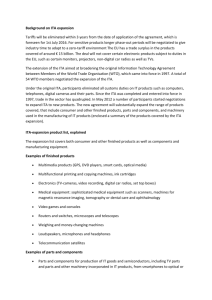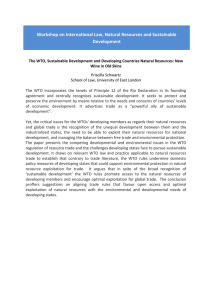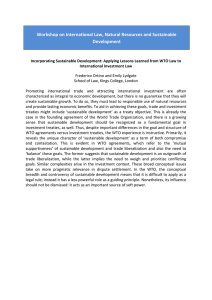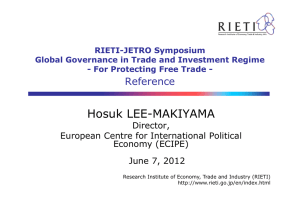Hosuk LEE-MAKIYAMA Handout Director, European Centre for International Political
advertisement
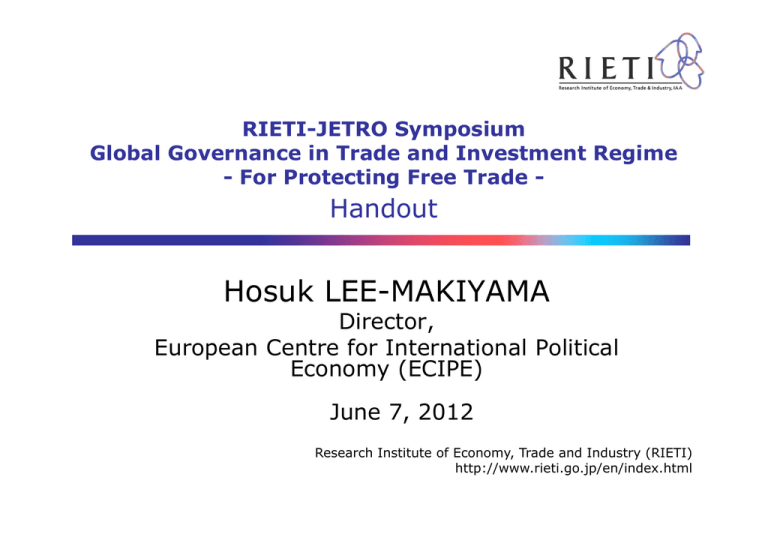
RIETI-JETRO Symposium Global Governance in Trade and Investment Regime - For Protecting Free Trade - Handout Hosuk LEE-MAKIYAMA Director, European Centre for International Political Economy (ECIPE) June 7, 2012 Research Institute of Economy, Trade and Industry (RIETI) http://www.rieti.go.jp/en/index.html ECIPE PRESENTATION » 07. 06. 2012 FROM THE WTO IT AGREEMENT (ITA) TO! INTERNATIONAL DIGITAL ECONOMY AGREEMENT Hosuk Lee-Makiyama Director, European Centre for International Political Economy (ECIPE) » WTO information technology agreement (ITA) ITA – open zero-for-zero agreement ! » Under MFN and critical mass approach (90%), with less than 10% free riders » Remains the largest trade liberalisation in the history of WTO » Expanded from 29 to 46 members ‣ ‣ ‣ Members theoretically account for 97% of trade in covered products Driven global production networks (GPN), services and supply chain fragmentation Radical shift from “intra quad” to south-south trade; developing economies accounting for 50% of today’s exports, involved in 75% of all trade » Failure to negotiate product expansion (ITA2) ‣ ‣ ‣ Gridlock over EU tariff dispute Flat-screen TV, set top boxes, multi-use printers (also PDAs/smartphones, digital still cameras) Defensive interests, legalistic interpretation of tariff schedules Unable to capture 15 years of technology development! » Fastest pace of innovation in human history ‣ Even products that are now outdated were yet to be invented in 1996 ‣ VHS; DVD; Blue-Ray; online downloads; cloud streaming » At least 4 innovation cycles, 12 product cycles and one industrial revolution ‣ 2 Internet, mobile technology » Trade policy challenges unique to the ICT industry Industry innovation versus legal commitments! » Product development and convergence » Servification, for example: ‣ ‣ Servification of goods – goods dependent on apps/software, outsourcing and consultancies Actual transformation of goods – cloud computing (PaaS, IaaS), digital content » Then: digital divide – Now: balkanisation of the ICT industry New trade barriers! » Non-tariff issues, data or services » Competences New signatories! » Mexico (2.1%), Brazil (8.1%), South Africa (1.1%), Argentina (9%), Chile (3%), Russia (3.7%) Not a question of new ‘issues’, ‘rules’ or ‘disciplines’ – but what WTO should do when trade volumes take new forms! » Needs already identified in the mid 90s ‣ ‣ 3 ‣ Cross-border data flows: WTO e-commerce moratorium Infrastructure: WTO Reference Paper on basic telecoms Goods: ITA » Elements for trade liberalisation ‣ ‣ ‣ ‣ Goods Services Infrastructure Competences Email/SMS Video/Still camera ! Geo-positioning, GPS Installations, application development infrastructure e.g. Lithium-Ion batteries Network Network access Components Assembly Voice/data Operating systems Applications Software supply chain Internet Content » Product coverage Current scope of ITA! » List of agreed goods by tariff lines (annex A) or product descriptions (annex B) » Problems of a subjective criteria, ‘professional use’ ‣ Definitions based on speed, capacity, available ports and connectivity are temporal ‣ Examples: Monitors (televisions), still cameras (video cameras), ‘professional’ software (content, apps) » Inherent problems of the harmonized standard (HS) code: the tablet? Proposed extension of the product coverage! » Definitions (+ parts, manufacturing equipment thereof) ‣ Two tier criteria ‣ ‣ ‣ 1. Any product whose main purpose is to register, store, process, communicate or render information 2. Digital products The new WTO proposal [ITA/W/36]: ‣ ‣ a) products capable of processing digital signals b) products that can send or receive digital signals with or without lines; » Category based commitments with negative list approach ‣ ‣ Current commitments are on product level (HS 6/8 digit level) New products require negotiations for each inclusion, cannot be automatically included The real coverage of current ITA! » 65% of world trade in digital goods ‣ 5 Average 5.3% tariff on non-covered items (approx. $ 12bn) » Non tariff barriers (NTBs) Examples! » Certification requirements, safety marking – but also non-market driven product standards that are mandatory, local content requirement Economic impediment of NTBs exceeds tariffs! » Trade costs arising from NTBs ~ $250 bn (cf. tariffs $12 bn) » Agreeing on testing/certification requirement on half of ITA goods would at least lead to 6~7% reduction of trade cost (equiv. to $80~90 bn) Issue! » ICT standards tend to be set by business under dynamic competition ‣ ‣ WTO extremely ill-fitting to be a standard-setting body (ISO, IEC, ITU) Principles for transparency or disproportionate discrimination actionable under dispute » Harmonisation on electromagnetic compability and interference (EMC, EMI) Competition from FTAs! » MRAs, Self-declaration of conformity (SDoC) » No real reason (from consumer & business perspective) why these techniques cannot be applied in a plurilateral context » Product liability 6 » Services Market developments! » ICT services are the fastest growing category of services ($1 trillion in US) ‣ ‣ Value of software traded as a services doubles every 3 years 75% of software distribution today online (previously floppy disks), rest via mode 4 » Goods depend on access or bundling with online services ‣ Tied to business and revenue models » Emerging markets participation ‣ India largest service exporter in the world; China is the world s largest internet population ICT Services! » Little restrictions in the GATS schedules of ITA members ‣ ‣ ITA members cover 96% of all trade on computer and related services (CRS, CPC84) Telecommunication: 85% » Limited members agreed on ‘basic’ telecom services (voice), not the internet ‣ ‣ GATS annex – open access on reasonable and non-discriminatory terms Reference Paper – universal service, interconnection, regulatory and licensing procedures » Locking in existing commitments on CRS ‣ 7 Making classification issues of software irrelevant » Mode 4 (Temporary movement of physical persons) Global supply-chain of competences! » Services fragmentation of multinational corporations (MNCs) » Market driven licensing/certifications under dynamic competition » Part of most new generation FTAs – ICT services (CPC84) more likely to be free. Less concerns about migration » EU FTAs: Mode 3 require Mode 4; India Possible solutions! » Intra corporate transfers » Abolishment of ENTs and similar requirements » Numerical quotas 8 39 bn ADDITION FROM ACCESSION BY ARGENTINA, BRAZIL, CHILE, MEXICO, RUSSIA, SOUTH AFRICA 89 bn CURRENT ITA TRADE VOLUMES $1310 bn 45 bn 3.4 bn EXPANDING PRODUCT COVERAGE AMONGST EXISTING ITA MEMBERS CURRENT SCOPE INCL COMMUNICATION SERVICES NEW MEMBERS + EXPANDED SCOPE (+4%) 3.5 bn INCL. VOLUMES BETWEEN ALL ACCEDING COUNTRIES ADDITION OF COMPUTER AND INFORMATION SERVICES EXPANDING MEMBERSHIP INCL. EXPANDED PRODUCT COVERAGE ADDITION OF COMMUNICATION SERVICES NEW MEMBERS (+10%) INCL COMPUTER & INFORMATION SERVICES » Priorities going forward MODE 3 + MODE 4 EXPANDED SCOPE ( > +26%)* 217 bn 91 bn EXPANDING SCOPE 9 31 bn * excl. mode 3 » Plurilaterals in the current policy climate Plurilaterals: A WTO of variable geometries?! » Liberalisation wherever it can be achieved » Failure of single undertaking, modalities and Hong Kong sequencing (Unctadification) » Critical mass agreements or non-mfn? ‣ ‣ ‣ Alternatives are non-MFN FTAs outside the WTO Services (ISA, ICT-only), TRIPS (ACTA) are deadlock pillars of the WTO Non-MFN plurilaterals are infeasible in current state of play Conclusions from ITA ! » Sectors where interests cuts through north/south divide ‣ ‣ More likely with supply-chain fragmentation without net importer mercantilism General purpose sectors (trade facilitation); Export enablers for emerging economies » Market access-only, clarity in definitions (cf. the Pharmaceutical Agreement) » MNC driven sectors, avoiding issue-linkages ‣ ‣ ‣ Trade negotiators reluctant to zero-for-zero WTO so far incapable of delivering regulatory co-operation – seeking solutions elsewhere Leveraging into non-market access issues Prospects of multilateralising ! » Plurilaterals move elements from bilateral FTAs into the WTO system 10 » Multilateral and plurilateral coverage ITA (1996 definition) 100.0% Pharmaceutical agreement 90.0% Telecom Reference Paper 80.0% 70.0% International Services Agreement 60.0% 50.0% GPA 40.0% 30.0% 20.0% MFN agreements 10.0% Non-MFN agreements 0.0% Dillon Kennedy 1960s Tokyo 1970s 1980 Uruguay (start) Uruguay (end) 1980s 1990s Doha/China Accession today 2000s 2010s ECIPE — European Centre for International Political Economy! ! Hosuk Lee-Makiyama Director hosuk.lee-makiyama@ecipe.org 12
